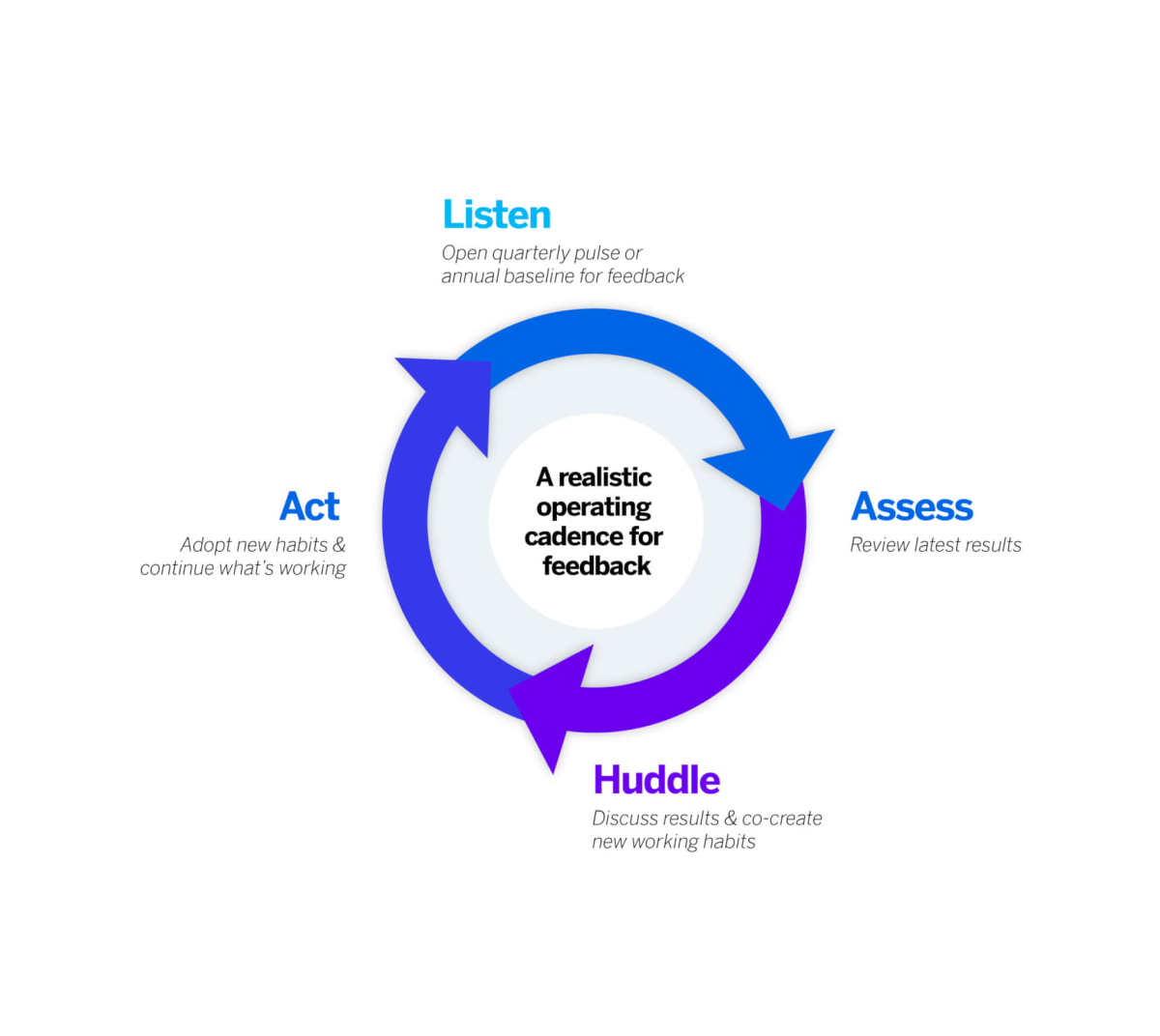A listening program will clue you in to your employees’ shifting priorities – and not only highlight what needs to happen in order to meet employee expectations, but offer you the insights you need to design and improve the employee experience to put your people first.
We take a closer look at what the employee experience (EX) is, why organizations measure EX, the key performance indicators (KPIs) and drivers of EX, how to influence them, plus how to get started driving change at your organization, below.
What is employee experience (EX)?
From the moment someone looks at your job opening, to the moment they leave your company, everything that the worker learns, does, sees, and feels contributes to their employee experience.
For your organization to master employee experience management, you must listen to your people at each stage of the employee lifecycle, identify what matters most to them, and create personalized, bespoke experiences.
Ultimately, it is their experiences – positive and negative – that will impact how hard they work, how much they collaborate, or whether they are invested in improving business performance.
Why do organizations want to measure EX?
Measuring employee experience allows organizations to gather data not only about engagement and its drivers, but also about the entire employee lifecycle. Crucially, this approach puts a heavier emphasis on the perspectives and experiences of the employees themselves.
Indeed, there are important touchpoints that happen throughout every employee’s journey: the first day, the performance review, ongoing training, getting promoted, and so on.
These are all moments that matter at work – and all moments that should be measured in order to improve the employee experience.
Free eBook: Design a world-class EX program that attracts and retains talent
What are the EX KPIs?
EX KPIs are the outcome measures that indicate how your organization is doing across key aspects of the employee experience.
At Qualtrics, we measure five KPIs:
1. Engagement
Employee engagement is strongly linked to organizational outcomes, such as performance, customer satisfaction, retention, and innovation.
2. Intent to stay
Once part of engagement, intent to stay will measure how long your employees intend to stay at your organization.
3. Experience vs. expectations
In this KPI, you will ask employees to indicate to what extent their expectations are met at work.
Answers will provide a unique perspective, reflective of employees’ individual expectations. Once you’ve collected listening data, you can easily segment results to differentiate the experiences of employees based on whether the organization is exceeding, meeting, or falling short of expectations.
4. Inclusion
Inclusion has quickly become a key differentiator between a positive working culture and a negative one. Inclusive organizations are more innovative, productive, and have higher retention.
5. Well-being
This important measure is becoming more critical as the lines between work and home increasingly blur. Employers must create working environments conducive to well-being, so that employees are not at risk of burnout, presenteeism, and/or low productivity.
What are the drivers of employee experience?
EX drivers are the aspects of the employee experience that influence the KPIs. Understanding each driver provides your organization with critical signals for where to start when it comes to improving your employee experience.
Request a demo and see EmployeeXM in action
The 25 EX drivers
Authority & Empowerment
Employees who feel they have autonomy over their work are more likely to want to stay at the company longer and be more engaged.
Collaboration
Work that is collaborative has been shown to lead to better employee attitudes, and collaboration itself is becoming increasingly important as work units become more cross-functional and sources of social connection.
Communication
Feeling that there is open communication is an important precursor to building trustful relationships in an organization, trust being a foundational aspect to a healthy working relationship.
Corporate Social Responsibility (CSR)
Corporate social responsibility is now a key driver of employee perception of their employers. Most employees want to work for companies that promote social causes and use their power and money to give back.
Customer Focus
Every company provides a product or service, and having a sense of pride in that product or service will naturally influence employees' sense of satisfaction, pride, and subsequent commitment to the organization.
Ethics
Integrity is often a core part of organizational purpose. Employees prefer to work for a company that stands for the right things in terms of how they do business.
Growth & Development
Growth is a fundamental human need beyond the workplace, and employees generally want to feel a sense of growth in their role and that their work is offering something to them.
Innovation
Being able to adapt, innovate, and create new ways of doing things or products and services is long seen as a critical aspect of a healthy organization, and one which many companies want to foster.
Living the Values
While most organizations have a set of company values, these values are much easier to create and promote than live by, which has led to the need to measure how much they are being role modeled and experienced through the company.
Managing Change
Being able to adapt to new market conditions, new competitors, or other external changes is fundamental to agility, and being able to help employees work through changes is critical to their attitudes at work.
Pay & Benefits
Reward is a hygiene factor for employees to feel that their skills are valued and appreciated. If employees are able to get significantly better pay and benefits elsewhere, it’s more likely they’ll explore moving on after a few bad weeks or months at work.
Performance & Accountability
Clear performance expectations and accountability is key to providing a fair deal for employees and increasing performance.
Psychological Safety
With the rise of the inclusion agenda, companies are realizing that providing environments where employees feel safe to speak up is healthy to inclusion, as well as engagement and a feeling of connectedness to the organization.
Recognition
Recognition is a core part of the employees’ contract with an organization and feeling unseen or unrecognized will inevitably lead to a reciprocal lack of commitment from employees.
Resources
When companies do not provide adequate resources to enable employees to be successful, this will ultimately lead to frustration and departure, a phenomenon most often seen with high performers.
Respect
Respect is the baseline and foundation of a healthy culture, and most organizations have expectations around respectful treatment in their employee handbook or code of conduct. Without feeling respected, there is little to build on.
Role Fit
An employee can love the company culture or their working location, but if they don’t find that their role is interesting or a fit for their skills, they are unlikely to want to stay long term.
Safety
Unlike other EX constructs, employee safety is a “100% item” – meaning that organizations should strive to close even the smallest gaps in employees’ experience, particularly in the post-pandemic workplace.
Strategic Alignment
When employees understand the broader direction of the company and how their role fits into that direction, employees feel like their work is more significant; therefore, providing this connection to all roles is a must.
Survey Follow-Up
Listening to and acting on feedback builds trust, and so any survey should include an item to measure the confidence employees have that their feedback will drive action. Our research shows that this item is an important precursor to engagement and well-being.
Training
Employees rightfully expect that the time is taken to train them on the specific aspects of their roles that are essential to success; thorough, relevant training is an opportunity for companies to demonstrate their willingness to invest in their people.
Trust in Leadership
Trust is a fundamental basis for any relationship. While many employees won’t have personal relationships with senior leaders, it’s important that they trust them to make the right decisions for the company.
Trust in Manager
If an employee trusts their manager, they are less likely to respond negatively to difficult circumstances. Trust also creates transparency, allows employees to be clear about their expectations, and provides the basis for healthy, long-lasting relationships.
Work-Life Balance
Engaged employees who don’t feel they have a good work-life balance are unlikely to see a long-term future with the organization. Work-life balance is increasingly a top consideration in assessing a new role.
Work Process
Too much process can result in unwanted bureaucracy, but too little results in a lack of structure and ability to scale. Naturally, how employees feel about their work processes influences how they feel about their ability to make progress in their work overall.
Want the full scoop on the 25 key drivers of EX? Download our free eBook here.
How do EX drivers influence KPIs?
To understand how drivers influence KPIs, it helps to understand the difference between KPIs and drivers.
One great analogy is health. Think of the KPIs as being health indicators such as heart rate, BMI, and blood sugar level.
If you want to influence these health indicators, you can’t impact them directly. Rather, you have to take action on the things that drive them, e.g., diet and exercise. After a few weeks or months of new habits around diet and exercise, you start to see the health indicators change.
It is the same with KPIs and drivers.
If you want to influence KPIs (like engagement, inclusion, and so on), you can’t impact them directly. Rather, you have to take action on the things that drive them (e.g., autonomy, growth & development, etc.). After a few weeks or months of new habits, you start to see the KPIs change.
The same goes for taking action on the things that drive…
- Company culture: To influence your company culture, you may want to focus on taking action on things that drive living your company values and trust in leadership.
- Positive relationships: To influence positive relationships at work, you may want to focus on taking action on things that drive communication and trust in managers.
- Work-life balance: To influence work-life balance at your organization, you may want to focus on taking action on things that drive autonomy and psychological safety.
- Job satisfaction: To influence job satisfaction levels, you may want to focus on taking action on things that drive pay and benefits, as well as role fit.
- A productive workforce: To influence productivity, you may want to focus on taking action on things that drive resources and strategic alignment.
How to get started influencing KPIs and drivers

To start seeing behavior change at your organization, we recommend the following four-step process:
Listen
In this step, you will open a quarterly pulse or annual baseline for feedback from your employees.
Discover how listening to your employees can improve your business
Assess
Set aside time to review results, consider them in the context of recent team events, and experience any potential reactions.
Huddle
Getting the team’s perspective is an important step between assessing feedback and acting on it. The discussion should take place in two stages:
- Discuss the results
- Suggest and agree on new ways of working
Act
Ultimately, the whole point of asking for feedback is to act on it! Asking for feedback and not acting on it can be more harmful than not asking for feedback at all. Over the weeks and months, the team should try out the new ways of working, find what works and what doesn’t, and reflect on this in the next results huddle.



